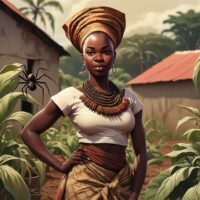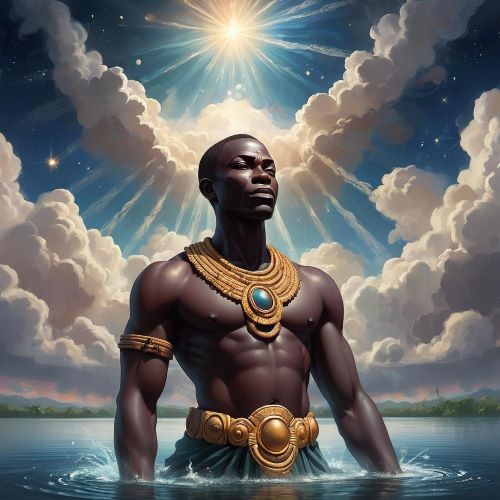Okonore Yaa : The Earth Mother
Listen
At a glance
| Description | |
|---|---|
| Origin | Akan Mythology |
| Classification | Gods |
| Family Members | Anansi (Husband), Ntikuma, Tikelenkelen, Nankonhwea, Afudohwedohwe, Anansewa (Children) |
| Region | Ghana |
| Associated With | Earth |
Okonore Yaa
Introduction
Okonore Yaa is a central figure in Akan mythology, remembered as the wife of the clever and mischievous trickster Anansi. While Anansi’s reputation as the cunning spider has spread far beyond Ghana and into the wider African diaspora, Okonore Yaa often remains in the background, embodying patience, resilience, and feminine strength. Her role is essential because she provides balance to Anansi’s unpredictable schemes, representing the grounded reality of family and community life.
The Akan people of present-day Ghana and Ivory Coast have passed down countless folktales, known as anansesem, where Anansi and Okonore Yaa appear together. Her character, though less flamboyant than her husband’s, reflects Akan values tied to endurance, labor, fertility, and the power of women in holding families and traditions together. To fully appreciate Anansi’s stories, one must also recognize Okonore Yaa’s contribution to Akan folklore and the moral lessons she embodies.
Physical Traits
Unlike Anansi, whose form shifts between spider, man, or a mixture of the two depending on the story, Okonore Yaa’s physical characteristics are rarely described in detail. This absence, however, is telling—it suggests that she is less a figure of spectacle and more a representation of the everyday Akan woman. In some modern illustrations and retellings, she is depicted as a hardworking farmer, wearing a headwrap and holding tools of cultivation, symbolizing her connection to the earth and to sustenance.
Rather than being defined by beauty or supernatural form, Okonore Yaa is portrayed through her actions and endurance. She embodies practicality over ornamentation, strength over flamboyance. Just as the earth itself does not boast but quietly nurtures, Okonore Yaa is presented as solid, reliable, and indispensable.
Family
Okonore Yaa’s most enduring role in mythology is as the wife of Anansi. Their relationship is often presented as comical and challenging, with Anansi trying to outwit others and frequently shirking responsibility while Okonore Yaa manages the consequences. Their dynamic reflects a broader cultural balance between chaos and order, mischief and responsibility.
Together, they have several children, each with exaggerated features or qualities that act as symbolic lessons. Ntikuma, the eldest son, is often wise beyond his years, standing in contrast to his father’s trickery. Tikelenkelen, with his oversized head, represents pride or arrogance. Nankonhwea, thin-necked and fragile, highlights weakness and awkwardness, while Afudohwedohwe, the pot-bellied son, embodies greed and indulgence. In some stories, they also have a daughter, Anansewa, whose beauty is central to later tales and even stage plays by Ghanaian playwright Efua Sutherland.
Through this mythological family, the Akan people explored aspects of human character, social responsibility, and morality. Okonore Yaa’s presence as the mother grounds these narratives, embodying care and resilience while Anansi pursues mischief.
Other names
As with many figures from oral traditions, Okonore Yaa is known by different names depending on the region or cultural adaptation. Among the Ashanti, she is commonly called Aso, while the Fanti often use the name Okonore Yaa. In diasporic communities across the Caribbean, she sometimes appears as Crooky or Shi Maria, names that reveal how Akan folktales evolved through the transatlantic slave trade.
She is also occasionally referred to as Konori or Konoro, variations that likely stem from local dialects and shifts in pronunciation over time. In theatrical or more contemporary versions of the stories, she has even been given names such as Ama Ananse or Sister Ama, which act as stage identities. These different versions of her name reflect the adaptability of folklore, where characters transform to fit new cultural contexts while still retaining their symbolic essence.
Powers and Abilities
Unlike Anansi, whose cleverness and trickster powers allow him to deceive gods, animals, and humans alike, Okonore Yaa’s strengths are quieter but no less significant. Her “powers” are tied to her endurance, wisdom, and symbolic role as a stabilizer.
She is frequently associated with farming and fertility, connecting her to the earth’s capacity to provide for communities. As a Thursday-born woman—since “Yaa” traditionally denotes a female born on Thursday in Akan naming customs—she carries spiritual associations with the earth, endurance, and patience. In many stories, she acts as the voice of reason, grounding Anansi’s chaotic schemes with practicality.
Okonore Yaa’s influence is not supernatural in a dramatic sense but moral and cultural. She represents the Akan ideal of womanhood—industrious, wise, and enduring in the face of hardship. In this way, her role as a counterbalance to Anansi becomes a form of power in itself.
Modern Day Influence
Okonore Yaa’s legacy has not been lost in the passage of time. Though her husband Anansi dominates the spotlight in global retellings, her character continues to appear in Ghanaian storytelling, Caribbean folktales, and adaptations of traditional anansesem. In Ghana, children still grow up listening to Anansi tales where Okonore Yaa plays a vital supporting role, reinforcing values of patience, family responsibility, and resilience.
In literature, her presence resonates indirectly through works like Efua Sutherland’s The Marriage of Anansewa, which reimagines Anansi’s daughter but draws on the family’s mythological foundation. In Caribbean folklore, Okonore Yaa under different names remains the ever-patient partner of the trickster, embodying the endurance of women in the face of hardship.
Modern scholarship and feminist reinterpretations have begun to reclaim Okonore Yaa as more than just a background figure. Some see her as a symbol of feminine resilience and the unsung labor of women who keep families and communities intact while men, like Anansi, seek adventure or chaos. Her symbolic role continues to resonate in discussions about gender, tradition, and cultural survival.
Okonore Yaa also finds relevance in educational settings, where anansesem are used to teach moral lessons and Akan values. Even in pop culture, video games and digital media inspired by African folklore occasionally include her character, ensuring that she remains a part of cultural storytelling in the digital age.
Related Images
Source
World History Edu. (2022, February 18). Anansi – the Trickster Spider-Man of West Africa. World History Edu. https://www.worldhistoryedu.com/anansi-the-trickster-spider-man-of-west-africa/
Wikipedia contributors. (2025, August 27). Anansi. In Wikipedia. https://en.wikipedia.org/wiki/Anansi
African Mythology Worldwide. (2025, February 9). The myths of the Akan: Legends from West Africa. African Mythology Worldwide. https://african.mythologyworldwide.com/the-myths-of-the-akan-legends-from-west-africa/
Sutherland, E. (1965). The Marriage of Anansewa: A Storytelling Drama. Longman.
Yankah, K. (1995). Speaking for the Chief: Okyeame and the Politics of Akan Royal Oratory. Indiana University Press.
Opoku, K. A. (1978). West African Traditional Religion. FEP International Private Limited.
Danquah, J. B. (1945). Religious Beliefs of the Akan.
Pemberton, J. (1990). Oríkì, women and the proliferation and merging of òrìṣà.
Frequently Asked Questions
What is lorem Ipsum?
I am text block. Click edit button to change this text. Lorem ipsum dolor sit amet, consectetur adipiscing elit. Ut elit tellus, luctus nec ullamcorper mattis, pulvinar dapibus leo.
What is lorem Ipsum?
I am text block. Click edit button to change this text. Lorem ipsum dolor sit amet, consectetur adipiscing elit. Ut elit tellus, luctus nec ullamcorper mattis, pulvinar dapibus leo.
What is lorem Ipsum?
I am text block. Click edit button to change this text. Lorem ipsum dolor sit amet, consectetur adipiscing elit. Ut elit tellus, luctus nec ullamcorper mattis, pulvinar dapibus leo.
What is lorem Ipsum?
I am text block. Click edit button to change this text. Lorem ipsum dolor sit amet, consectetur adipiscing elit. Ut elit tellus, luctus nec ullamcorper mattis, pulvinar dapibus leo.
What is lorem Ipsum?
I am text block. Click edit button to change this text. Lorem ipsum dolor sit amet, consectetur adipiscing elit. Ut elit tellus, luctus nec ullamcorper mattis, pulvinar dapibus leo.











Emmet Padberg
you are in reality a just right webmaster The site loading velocity is incredible It seems that you are doing any unique trick In addition The contents are masterwork you have performed a wonderful task on this topic
Wendell Collins
Just wish to say your article is as surprising The clearness in your post is just cool and i could assume youre an expert on this subject Fine with your permission allow me to grab your RSS feed to keep updated with forthcoming post Thanks a million and please keep up the enjoyable work
Zane Corkery
Your blog is a shining example of excellence in content creation. I’m continually impressed by the depth of your knowledge and the clarity of your writing. Thank you for all that you do.
Johan Rice
Every time I visit your website, I’m greeted with thought-provoking content and impeccable writing. You truly have a gift for articulating complex ideas in a clear and engaging manner.
Elaina Bruen
I wanted to take a moment to commend you on the outstanding quality of your blog. Your dedication to excellence is evident in every aspect of your writing. Truly impressive!